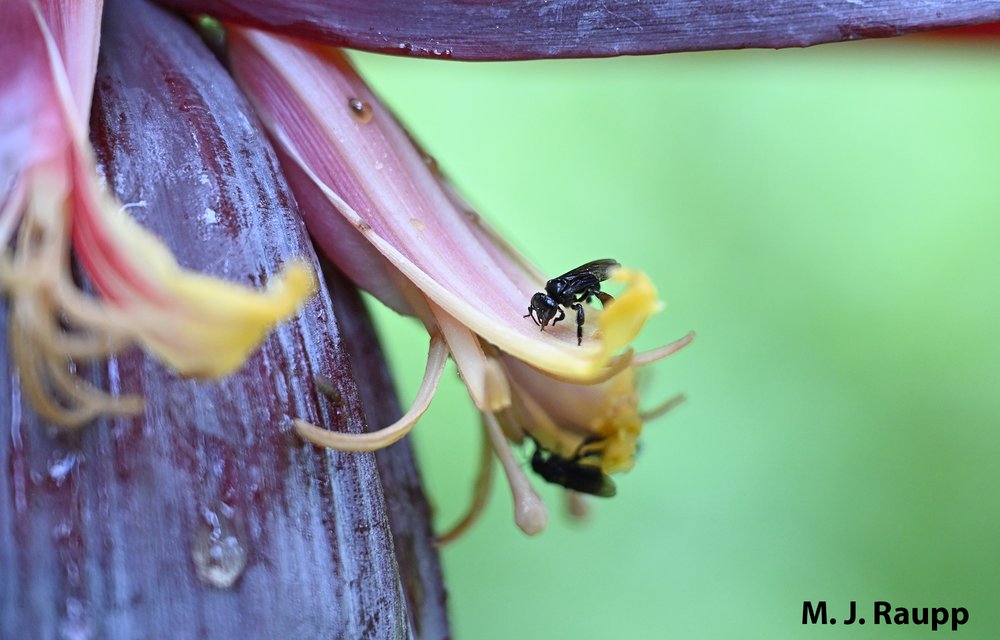Bananas in Belize get some help from stingless bees: Stingless bees, tribe Meliponini

Stingless bees in the genus Trigona are important native pollinators for their evolutionary plant partners in Belize, and also for non-native crops like bananas.
In the last episode, we visited non-migratory monarch butterflies enjoying benign temperatures in Florida while many of us shivered under bone chilling weather in other parts of the country. This week we head further south to Belize to visit amazing stingless bees in the tropical rainforests of Belize. Let’s go!

While several workers guard the entry to the colony, a pretty worker is on its final approach to the nest.
While visiting the Toucan Research Ecology and Education Society, we stumbled on a young banana tree in its blooming glory. There, amongst the blossoms, a bevy of stingless bees were busily pollinating a remarkable blossom. For many, the notion of stingless bees is an alien concept. I once had a viewer comment that these could not be bees because they did not sting. Well, a large clan of bees belonging to the tribe Meliponini are true bees with a wide distribution around the world. They live in colonies and make honey. Although they do not sting, they have other defenses which we will visit below. Typical nesting sites for stingless bees include tree hollows and crevices in the ground. Often these hollows have rather large openings. To limit access to the colony and facilitate defense, these large openings are narrowed to trumpet-shaped entrances constructed with a sticky substance called propolis, a mixture of wax and other materials. This creates a defensible portico where ants and other nest raiders, those that would love to enter the colony and plunder the honey, pollen, and baby bees inside, can be repelled.
In addition to natural cavities, stingless bees take advantage of human-made structures to build their nests. While visiting Mayan ruins at Xunatunich and the Jaguar Preserve in the Cockscomb Basin Wildlife Sanctuary, we discovered several colonies of stingless bees occupying cinder block walls of a building where small cracks in the mortar provided perfect entryways to the hollow cavities inside the walls. One colony in a cinder block wall was comprised of stunningly beautiful delicate bees in the genus Tetragonisca known locally as mariolas. They went about their business seemingly oblivious to students and a bug geek with a camera. However, a second darkly colored species of Trigona was not nearly as docile. The nest entrance was guarded by several workers that watched carefully and mounted a surprising attack when humans ventured too close. The assault consisted of dozens of workers flying into faces and hair of the nearby humans. They seemed to pay special attention to eyes, noses, and ears. Although they lacked stingers, their annoying bites were very persistent, forcing the intruders to vacate the vicinity of the hive. In his book “The Insect Societies”, E.O. Wilson describes accounts of stingless bees attacking human intruders. Some species eject an irritating liquid that causes a burning sensation to skin. This trick has earned them the local name of cagafogos, or “fire defecators”, in Brazil. So potent is this defense that it may dissuade very aggressive attackers like army ants from entering nests.
Bananas are one of my favorite fruits. And in the rainforests of Belize native stingless bees pollinate this non-native plant in addition to myriad native plants with which they evolved. Worker bees gather sweet nectar and rich pollen and return it to the hive to feed the queen and bee babies. When their work is complete and pollination is accomplished, the banana says goodbye to the blossoms and the bees.
A visit inside a stingless bee colony would reveal the queen busily filling brood cells with eggs, most of which will become workers. The life of a worker bee is a predestined regimen of tasks that change as the bee ages. For the first several days of life, worker bees are craftsman shaping and forming the basic building materials of the colony, wax and a wax-like material called cerumen. After a week or so and for several weeks thereafter, workers stock cells with food and have the heady assignment of feeding the queen. About this time, they also begin to produce wax to build the many structures of the nest. Soon workers enter guard duty at the nest entrance. Shortly thereafter, they take on the assignment of collecting nectar and pollen for the hive.
Typical nesting sites for stingless bees include tree hollows and crevices in the ground. In addition to natural cavities, stingless bees take advantage of human-made structures to build their nests. While visiting Mayan ruins we saw a colony of Trigona bees nesting in a crack in a palace wall. At the Jaguar Preserve in the Cockscomb Basin Wildlife Sanctuary, we discovered several colonies of stingless bees occupying cinder block walls of a building where small cracks in the mortar provided perfect entryways to the hollow cavities inside the walls. To limit access to the colony and facilitate defense, trumpet-shaped entrances constructed with a sticky substance called propolis create a defensible portico to repel ants and other nest raiders.

At the Mayan ruin of Xunantunich, students discover Mayan history, culture, and insects of the tropical rainforest.
Worker bees are common visitors to many kinds of flowering plants in the Belize and many other Central American rainforests. I have captured some species and gently rolled them between two fingers. Don’t ask why I did this, but they emitted a pleasant floral odor before I released them. For centuries, ancient Mayans maintained colonies of stingless bees to produce honey used for sweetening foods and to produce a fermented drink similar to mead. Unfortunately, with the introduction of Africanized bees and domestic honeybees, the number of colonies of stingless bees has declined dramatically and husbandry of stingless bees is becoming a lost art. In addition, fragmentation and loss of natural forests in Central and South America threaten many species of marvelous stingless bees and the tropical plants they evolved to pollinate.
Acknowledgements and References
We thank Drs. Dan Gruner and Paula Shrewsbury, the hearty crew of BSCI 339M: Tropical Biology and Maya Culture, and our fearless guide, Wilford, for providing the inspiration for this episode of Bug of the Week. The fascinating book “The Insect Societies” by E.O. Wilson, and the articles “Behavioural and developmental responses of a stingless bee (Scaptotrigona depilis ) to nest overheating” by Ayrton Vollet-Neto, Cristiano Menezes, and Vera Lucia Imperatriz-Fonseca, and “Maya Beekeeping Tradition Fades” by Stefan Lovgren were used as references for this Bug of the Week.
This post appeared first on Bug of the Week